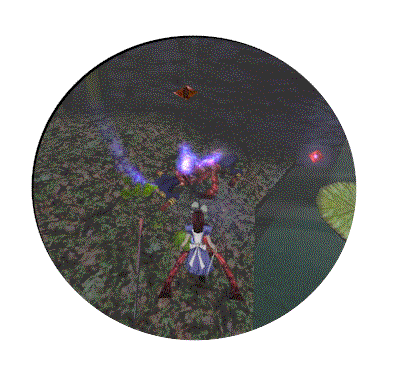
By Bas Debbink, 2001
I think it is time for another evolution in the computer world. This site is dedicated to an idea I had regarding presentation of material on PCs of the future, circular content. Even though this idea started out as a novelty, thinking it over a few times has given me the feeling that it is in fact a feasible, and in some ways superior, way of presenting content.
Why indeed? The square and rectangle are not natural shapes. In contrast, the circle is one of the most perfect natural shapes. It would seem logical to present content in a shape that is more natural to the eyes than a bordered, rectangular shape. Isn't a field of vision circular?
I am not a mechanical engineer by a long shot. However, I don't see how it can be any harder, if at all, to create a circular CRT tube or LCD screen than it is to create a rectangular one. The same goes for the casing. One could also convert a rectangular casing so that the display area is round, while the casing itself is rectangular.
Using simple trigonometry should take care of the positioning problem. Rather than identifying a point on the screen as x, y where 0,0 is the top left point on the screen, a point on the display will be calculated as x,y and the formula x² + y² < R² (where R is the radius of the screen, and the center of the circle is 0,0) makes sure the point falls inside the display area. Or you could use Carthesian coordinates where a point at a distance r from the center at an angle with the horizontal phi [rad] is defined by x=rcos(phi) and y=rsin(phi). I'll leave it up to the designers which method is easier.
Currently, all content is presented in a rectangular way: think of books, magazines, billboards, TV, etc. Changing the way traditional, readable content is presented would be beyond the scope of my idea. Circular presentation will not change the way content is presented in Wordprocessors, Spreadsheets, Desktop Publishing Tools, etc. This does not mean that these applications can't be used in circular display devices, the presentation of the application itself could very well be circular, while the document presentation is rectangular. I will show this in some examples later on.
Circular content presentation, in my opinion, would be most beneficial to graphics designers, industrial designers, and the gaming industry. Any form of primarily visual presentation in other words. I am somewhat surprised at my realization that even in the art world, most two-dimensional content is presented on rectangular media, e.g. paintings, sketches, etc. I hope that me presenting a different way of presenting content will stimulate minds in both the technical and artistic world.
Below is an example of a FPS (First Person Shooter) in circular context. To me, presenting the game this way would add to the realism, since the borders are similar to a person's natural peripheral vision. Any kind of game would benefit from having its content presented in circular form.

Again, I believe the arts are the perfect playground for circular presentations. The presentation area can be in any shape, the application area can be designed in various ways as well. Here is an example of how the screen could be laid out for a graphics application.

The Internet pretty much follows the printed format when it comes to presentation of content. This does not mean that the browser itself can't be made more functional, or more attractive when presented in a circular shape. Content might follow automatically.

© 01/2001 Bas Debbink
All the ideas presented in this publication are the intellectual property of Bas Debbink, and may not be reproduced without my permission.
Feel free to contact me with feedback, flames shall be dealt with in an appropriate manner (i.e. Del key)